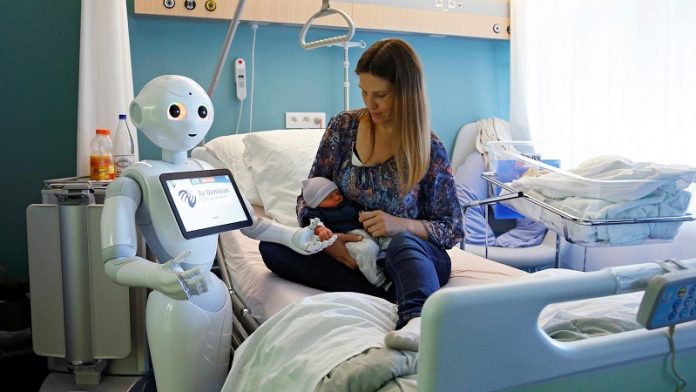Even before the pandemic, Healthcare was on the road to becoming even more digital. By 2018, individual patients were generating more than 80 megabytes of EMR (electronic medical records) and imaging data each year, which is manageable in isolation but incredibly challenging at scale. COVID-19 supercharged this shift with a sudden pivot to telemedicine and at-a-distance diagnoses. However, that’s not the end of the road.
The coronavirus pandemic has driven unexpected innovations in automation, while at the same time revealing bottlenecks to deploying robotic systems in health care settings. They contend that advances in human-robot interaction—such as improving robots’ capabilities to feel, touch, and decide—will determine if the robots of tomorrow will help hospitals stay ahead of the next pandemic.
It can be acknowledged in three ways robots have that greatly enhanced patient care and provider safety during COVID-19: minimizing contact between infected patients and care providers, reducing the need for PPE, and giving providers more time to focus on critical tasks. This individually hailed the benefits that the advanced technology will be catering to the world and how technologies can be leveraged to develop adaptable and reliable robots for future infectious disease crises.
Health Care Robotics
You go into a pandemic with the robots you have, not the robots you wish you had. We can’t build a fleet of robots for an emergency and put them in a warehouse. Not only is that not economically viable, but by the time you need them, they could be obsolete. One thing we recognized is that we need to build core capabilities into deployed systems that can be easily adapted for the challenges of the moment.
We already had robots that delivered meals or could take a patient’s temperature. Now we are talking about much more sophisticated systems—that can do serious cleaning, that can perform nursing tasks, that can do many things beyond just delivering supplies—and that presents some interesting engineering challenges.
A big issue has been deployability and how quickly a non-expert user can customize a robot. For example, our ICU ventilator robot was designed for one kind of ventilator that pushes buttons. But some ventilators have knobs, so we need to be able to add a modality so that the robot can also manipulate knobs. Say you want one robot that can service multiple ventilators; then you’d need a mobile robot with an arm attachment, and that robot could also do plenty of other useful jobs on the hospital floor.
Future robots will play a more significant role in clinical care for infectious disease, but there are still barriers to have robotic tools ready for when the next pandemic hits.
The pandemic has shown some of the current limitations of robotic systems to robustly work and adapt in difficult, changing environments at large scales. Robots in busy hospitals need to be able to manage unexpected events and uncertainty. Research needs to focus on advancing the autonomy and learning strategies for health care robots, so they can perform tasks with only limited supervision. The most realistic approach for health care robots in the near future is shared autonomy, which combines the knowledge of medical experts with the capabilities of robots.
The Benevolence Of Robotics with Frontline Healthcare Workers
A Healthcare provider needs to put on fresh PPE every time they enter the room where an infectious patient is being treated. Robots don’t need to wear PPE, so that frees up valuable supplies and time for human providers. The more robots can do, the more it allows human providers to devote their attention to other aspects of care.
A big area that engineers should focus on is enhancing the ability of robots to perform fine motor tasks, so they can perform direct patient care tasks such as placing an IV, intubating the trachea, or inserting central lines. Other potential tasks could include basic room cleaning, phlebotomy, and ventilator and monitor management and manipulation.
Healthcare providers and patients need to be comfortable both with the functionality of robotic systems as well as the actual human-robot interface. There are certain tasks that patients might prefer to be performed by a human clinician. In addition to task selection, patients and caregivers can provide important feedback about the materials used in robotic construction—particularly in components that directly touch a human patient—as well as the overall design.
The next big inquiry would of mobile autonomy and situational awareness: how can a computer develop enough information about the environment so that it can do the task it is supposed to do, and how can it relate its general motion and sensing capabilities to that specific task? If a robot is asked to clean a room that it must have a prior idea with accurate analysis about the placement of things in that room. the robot needs to be able to understand what is in the room and what needs to be cleaned, and that changes from day to day and room to room.
Surviving the pandemic wasn’t easy and the sole reason why we’ve made it through is because of the healthcare sector.
By Mayank Vashisht | Technology Journalist | ELE Times








